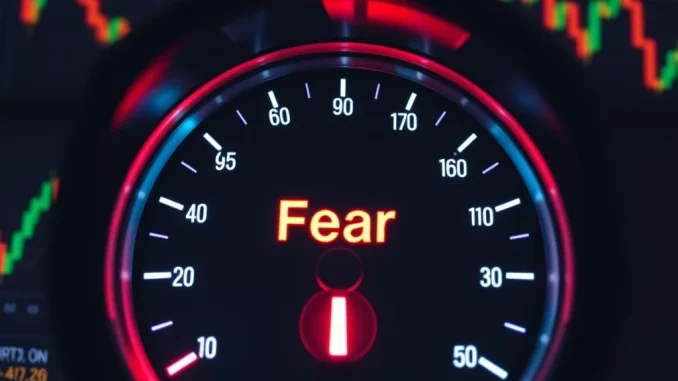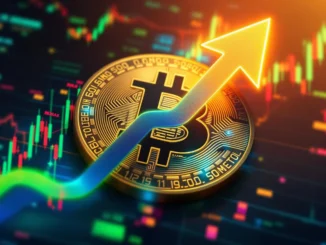
Is the crypto market on edge? The latest reading of the Crypto Fear & Greed Index suggests exactly that. Climbing three points to a score of 28, the index has officially shifted from ‘Extreme Fear’ into ‘Fear’. This subtle but significant move indicates a shift in overall crypto market sentiment, and it’s crucial for investors to understand what this means. Let’s dive into what’s driving this change and how you can navigate these potentially choppy waters.
Decoding the Crypto Fear & Greed Index: Your Market Sentiment Compass
The Crypto Fear & Greed Index, a valuable tool developed by Alternative.me, acts as a barometer for the prevailing emotions in the cryptocurrency market. Think of it as a sentiment compass, pointing towards whether the market is dominated by fear or greed. This index operates on a simple scale:
- 0-24: Extreme Fear – This zone typically indicates that investors are excessively worried, often signaling potential buying opportunities as assets may be undervalued.
- 25-49: Fear – Still in the cautious zone, ‘Fear’ suggests investors are apprehensive, and market uncertainty is prevalent.
- 50-74: Greed – As the index climbs into ‘Greed’, it suggests increasing market optimism and a willingness to take risks.
- 75-100: Extreme Greed – This is the peak of bullish sentiment, often a warning sign of a potential market bubble, where excessive optimism might lead to overvalued assets and increased risk of correction.
Currently sitting at 28, the fear index is signaling that while ‘Extreme Fear’ has subsided slightly, apprehension still dominates the crypto landscape. But what factors contribute to this reading, and how is it calculated?
Unpacking the Factors: What Drives the Fear & Greed Index?
The Crypto Fear & Greed Index isn’t based on guesswork. It’s a data-driven analysis, weighing six key market indicators to gauge overall sentiment:
- Volatility (25%): Measures the rapid and significant price swings in the Bitcoin market. High volatility often correlates with fear, as uncertainty increases.
- Market Momentum/Volume (25%): Examines trading volume and market momentum in comparison to recent averages. Strong momentum can suggest greed, while weak momentum may indicate fear.
- Social Media (15%): Analyzes sentiment on social media platforms, particularly Twitter, to gauge public perception and discussions around cryptocurrencies.
- Surveys (15%): While currently paused, surveys previously directly measured investor sentiment and expectations.
- Bitcoin Dominance (10%): Tracks Bitcoin’s market capitalization relative to the rest of the cryptocurrency market. Increased Bitcoin dominance can sometimes signal a ‘flight to safety’ during fearful times.
- Google Trends (10%): Analyzes Google search queries related to Bitcoin and crypto terms to understand general public interest and curiosity.
By combining these diverse data points, the index provides a holistic view of the market’s emotional temperature. The recent shift from ‘Extreme Fear’ to ‘Fear’ suggests a subtle easing of anxieties, but the market remains far from euphoric.
Navigating the ‘Fear’ Zone: What Does This Mean for Bitcoin and Crypto?
The move into the ‘Fear’ zone, while seemingly negative, isn’t necessarily a cause for alarm. In fact, for astute investors, it can present potential opportunities. Here’s what to consider:
- Potential Buying Opportunity? Historically, periods of ‘Fear’ and ‘Extreme Fear’ have often preceded market rebounds. When fear is high, assets can be undervalued, creating entry points for long-term investors. Is this the right time to consider accumulating Bitcoin or other cryptocurrencies?
- Market Correction or Consolidation? The shift could indicate a temporary reprieve in selling pressure after a period of ‘Extreme Fear’. It might signal a period of market consolidation before the next major move, either upwards or downwards.
- External Factors: Remember that the Crypto Fear & Greed Index is just one tool. It’s crucial to consider broader economic factors, regulatory developments, and global events that can influence the crypto market.
- Risk Management is Key: Regardless of the index reading, robust risk management is paramount. Never invest more than you can afford to lose, and diversify your portfolio to mitigate potential downturns.
To further illustrate, let’s look at a simplified table of how different Fear & Greed Index readings might be interpreted in terms of potential investment strategies:
| Fear & Greed Index Range | Market Sentiment | Potential Investment Strategy |
|---|---|---|
| Extreme Fear (0-24) | Extreme Pessimism, Potential Undervaluation | Consider Dollar-Cost Averaging (DCA), Long-Term Accumulation |
| Fear (25-49) | Apprehension, Uncertainty | Cautious Accumulation, Monitor Market Developments Closely |
| Greed (50-74) | Optimism, Increased Risk Appetite | Selective Investing, Profit Taking, Risk Management |
| Extreme Greed (75-100) | Euphoria, Potential Market Bubble | Reduce Exposure, Secure Profits, High Alert for Correction |
Conclusion: Staying Informed and Agile in the Crypto Landscape
The Crypto Fear & Greed Index‘s move into ‘Fear’ serves as a timely reminder of the inherent volatility and emotional swings within the cryptocurrency market. While ‘Extreme Fear’ has lessened, caution remains the prevailing sentiment. By understanding and monitoring this index, alongside other market indicators and news, you can make more informed decisions and navigate the crypto landscape with greater confidence. Remember, knowledge is power in the world of crypto, and staying informed is your best strategy to thrive, regardless of whether the market is gripped by fear or fueled by greed.



